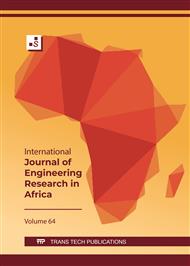[1]
F.C. Ibezim, Optimization of Energy Consumption of a Synthetic Ammonia Process. Bachelor of Engineering Project Report Submitted to Afe Babalola University, Ado-Ekiti, Ekiti State, Nigeria, 2021.
DOI: 10.26420/austinhematol.2021.1041
Google Scholar
[2]
C.D. Demirhan, William W. Tso, Efstratios N. Pistikopoulos, Process Synthesis and Global Optimization of novel ammonia production processes, AIChE Annual Meeting, Minneapolis, MN, (2017) 1-8.
Google Scholar
[3]
J.W. Erisman, M.A. Sutton, J. Galloway, Z. Klimont, W. Winiwarter, How a century of ammonia synthesis changed the world, Nat. Geosci. 1 (2008) 636–639.
DOI: 10.1038/ngeo325
Google Scholar
[4]
V. Smil, Detonator of the population explosion, Nature 400 (1999) 415.
DOI: 10.1038/22672
Google Scholar
[5]
H.R.K. Rouwenhorst, S. Anthony Travis and L. Lefferts. 1921–2021: A century of renewable ammonia synthesis, Sustain, Chem. 3 (2022) 149-171.
DOI: 10.3390/suschem3020011
Google Scholar
[6]
G. Soloveichik, NH3 Energy Future of ammonia production: improvement of haber-bosch process or electrochemical synthesis?" in Topical conference: AIChE annual meeting, Minneapolis, October 29–November 3, 2017.
Google Scholar
[7]
S. Ghavam, M. Vahdati, I.A.G. Wilson and P. Styring, Sustainable ammonia production processes, Frontiers in Energy Research, 9 (2021) 1-19.
DOI: 10.3389/fenrg.2021.580808
Google Scholar
[8]
K.H.R. Rouwenhorst, P.M. Krzywda, N.E. Benes, G. Mul, L. Lefferts, Ammonia production technologies, In Techno-Economic Challenges of Green Ammonia as Energy Vector; Bañares-Alcántara, R., Valera-Medina, A., Eds.; Elsevier Inc.: Amsterdam, The Netherlands, (2020) 41–84.
DOI: 10.1016/b978-0-12-820560-0.00004-7
Google Scholar
[9]
O.A. Hatfield, Review of global ammonia supply. 2020. Available online: https://www.ammoniaenergy.org/wp-content/uploads/2020/12/Oliver-Hatfield.pdf (accessed on 19 March 2021).
Google Scholar
[10]
International Renewable Energy Agency (IRENA). Ammonia energy association, In Production, Market Status and Future Prospects of Renewable Ammonia; IRENA: Masdar City, United Arab Emirates, 2022.
Google Scholar
[11]
The Royal Society. Ammonia: zero-carbon fertiliser, fuel and energy store. 2020. Available online: https://royalsociety.org/-/media/policy/projects/green-ammonia/green-ammonia-policy-briefing.pdf (accessed on 19 March 2021).
Google Scholar
[12]
J. Jiang, X. Feng, Energy optimization of ammonia synthesis processes based on oxygen purity under different purification technologies. Energy, Elsevier, 185(C) (2019). 819-828.
DOI: 10.1016/j.energy.2019.07.094
Google Scholar
[13]
J. Jiang, X. Feng, M. Duan, Z. Zhang, Energy consumption optimization of a synthetic ammonia process based on oxygen purity. Chemical Engineering Transactions, 70 (2018) 481-486.
Google Scholar
[14]
H. Cheung, Moderate-pressure cryogenic air separation process. Gas Separation and Purification, 5 (2008) 25-28.
DOI: 10.1016/0950-4214(91)80045-7
Google Scholar
[15]
Z.A.M. Khalel, A.A. Rabah, T.A.M. Barakat, A new cryogenic air separation process with flash separator. ISRN Thermodynamics, 2013 (2013) 1-4.
DOI: 10.1155/2013/253437
Google Scholar
[16]
S.N. Sapali, V. Raibhole, Exergy analysis of cryogenic air separation unit integrated with biomass gasifier. Proceedings of the World Congress on Engineering and Computer Science, 2 (2013) 323-390.
Google Scholar
[17]
Q. Fu, L. Zhu, X. Chen, Complete equation-oriented approach for process analysis and optimization of a cryogenic air separation unit. Ind. Eng. Chem. Res., 54(48) (2015) 12096–12107.
DOI: 10.1021/acs.iecr.5b02768
Google Scholar
[18]
A. Ebrahimi, M. Meratizaman, , H.A. Reyhani, , O. Pourali, M. Amidpour, Energetic, exergetic and economic assessment of oxygen production from two columns cryogenic air separation unit. Energy, 90(2) (2015) 1298-1316.
DOI: 10.1016/j.energy.2015.06.083
Google Scholar
[19]
D. Xiang, Y. Zhou Concept design and techno-economic performance of hydrogen and ammonia co-generation by coke-oven gas-pressure swing adsorption integrated with chemical looping hydrogen process, Applied Energy, 229 (2018) 1024-1034.
DOI: 10.1016/j.apenergy.2018.08.081
Google Scholar
[20]
M.J. Palys, P. Daoutidis, Using hydrogen and ammonia for renewable energy storage: a geographically comprehensive techno-economic study, Computers & Chemical Engineering, 136 (2020) 106785.
DOI: 10.1016/j.compchemeng.2020.106785
Google Scholar
[21]
P. Arora, I. Sharma, A. Hoadley, S. Mahajani, and A. Ganesh, Remote, small-scale, 'greener' routes of ammonia production, J. Clean. Prod. 199 (2018) 177–192.
DOI: 10.1016/j.jclepro.2018.06.130
Google Scholar
[22]
L. Cong, Z. Yu, F. Liu, and W. Huang, Electrochemical synthesis of ammonia from N2 and H2O using a typical non-noble metal carbon-based catalyst under ambient conditions, Catal. Sci. Technol. 9 (2019) 1208-1214.
DOI: 10.1039/c8cy02316f
Google Scholar
[23]
Aspen, Aspen Plus V11 (37.0.0.395). Aspen Technology, USA, 2019.
Google Scholar


